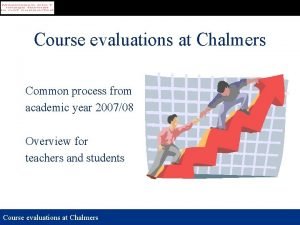IDEA Course Evaluation Overview Whats New with Online














- Slides: 14

IDEA Course Evaluation Overview

What’s New with Online IDEA Course Evaluations? • Reports available 3 days after grades are due for the session, term, or semester. • Reports will now include student comments • Survey items reduced from 47 to 43 items – Added four new learning objectives on diverse perspectives, ethical reasoning, civic engagement, and quantitative literacy, improved information literacy wording • Ability to add custom questions: scale response or openended • Saving almost 70, 000 pieces of paper semester

IDEA Center/Campus Labs • The IDEA Center provides the revised IDEA Diagnostic Feedback Instrument and support regarding the instrument and interpretation of results. Fun Fact: IDEA stands for Individual Development and Educational Assessment. • The Campus Labs provides the technology platform that makes the online process possible. Campus Labs provides support and help related to using the platform.

Get started with the IDEA Course Evaluation Checklist • An interactive checklist with links to helpful resources: https: //web. uri. edu/teach/course-evaluation-checklist/

How do you get started? • Got to URI’s IDEA Course Evaluation Launch Page: https: //web. uri. edu/idea • Login to Campus Labs Platform Click here to log in

Check your courses for the current session or term Cl ick h er e to s et o bj ec tiv es Current term displayed here

Rate the importance of learning objectives As a general rule, prioritize what you want students to learn by selecting no more than 3 -5 objectives as “Important” or “Essential”. When calculating Progress on Relevant Objectives, IDEA weighs Minor/Not Relevant “ 0”, Important objectives “ 1”, Essential objectives “ 2” • Your selections are used to calculate the Progress on Relevant Objectives (PRO) Score (see box for weighted average info). • Select 3 -5 objectives WARNING: If none selected, all objectives included in PRO Score as ”Important” • Unless one of the relevant objectives is addressed significantly more than others, rate all “Important. ” • Not required to have any ”Essential” • Link: Campus Labs “how-to” page with videos • Link: IDEA Center resources for identifying relevant objectives

Decide whether to add custom questions • Must be added before the evaluation period opens • Check the questions already in the survey instrument Link: IDEA Diagnostic Feedback Instrument • Choose between multiple choice questions with scales or openended questions WARNING: Avoid adding too many questions • Link: Campus labs “how-to” videos and instructions • Link: Example questions by type of face-to-face courses • Link: Example questions for online courses

3 Example Open-Ended Questions 1. What in this course has really helped you learn? 2. What could be improved about this course? 3. For future students in the course, what would you recommend they do to increase their learning? Advise students that their comments are anonymous, but polite and constructive feedback is taken more seriously by instructors and departments.

Response rates matter • Achieving higher than 65% response rate is the goal across URI • The number one strategy is to treat the online course evaluations the same as paper versions and provide time in class for students to complete. – Campus Labs indicates average time to completion is 18 -21 minutes. We recommend giving students at least 15 minutes. • Research shows students are more likely to complete is they know faculty value their response. – We recommend instructors explain how they have used student feedback in the past or why their feedback is important to you. • Once started and students click past the first page their responses are saved every time students click next page. • Data from incomplete surveys is included in reports. • Students can return to any survey and edit responses until the end of the survey period.

Preparing for face-to-face classes • Choose class session – Recommendation: Administer course evaluations at beginning rather than end of class • Announce date & need for internet capable device – Recommendation: Course evaluations open 2 weeks before the last class meeting. Announce schedule for course evaluations during this first week. Students will see your course when they log in for other course evaluations. Let them know you will dedicate class time for filling these out is important. – The university has made arrangements for loaner devices to be available at several locations on campus. For details email: uricourseeval@etal. uri. edu – Remind students to bring a charged device

Administering the survey in class • Set aside at least 15 minutes. • Explain the value of student feedback. • Connect course learning outcomes with relevant IDEA learning objectives. Recommendation: Create a slide showing key course learning outcomes from syllabus that connect with your relevant learning objectives (important or essential). This particular important if you used different course specific language to describe these. Leave this up. • Encourage students to fill in comment field. Recommendation: Explain to students that their comments are anonymous, but polite and constructive feedback is taken more seriously by instructors and departments • Send students to https: //web. uri. edu/idea • Leave room while students complete.

Preparing for online classes • Choose a deadline for completion • Consider creating an Assignment called Course Evaluation. In the assignment, you can: • Select a due date that students will see in the calendar. • Select “No Grade” for Grade Scale option. In the assignment description: • Explain the value of student feedback. • Connect course learning outcomes with relevant IDEA learning objectives. • Encourage students to fill in comment field (see recommendation on face-toface slide). • Send students to https: //web. uri. edu/idea • Announce due date a week ahead. • Remind students of importance before due. • Thank students for providing feedback.

Final steps for all courses • After 24 hours, check course response rate. The goal is 65% or greater. Response rates are reported in your table of “My Courses. ” The response rate is updated continuously and refreshed a minimum of every 30 minutes. • Message students to reiterate importance and request their help. • Give students a 24 hr or 48 hr “deadline” to complete. Sample message: “I just checked the course evaluation website and the response rate is 56% for this class. My goal is to get feedback from at least 80% of the class in the next 24 hours. If you haven’t completed the survey yet, I hope you will take some time to do it as soon as possible. I’ll be checking if you can beat my goal. ” • Repeat if needed. • Review student feedback. (Available 3 days after grades are due. ) Link: Guide to new interactive reports
 Uri idea survey
Uri idea survey Exchange online protection overview
Exchange online protection overview Course evaluation chalmers
Course evaluation chalmers Strategic management objectives
Strategic management objectives Central idea main idea
Central idea main idea Exegetical idea vs homiletical idea
Exegetical idea vs homiletical idea Suporting idea
Suporting idea What is the difference between topic and theme
What is the difference between topic and theme Supporting sentence example
Supporting sentence example Tells more about the main idea
Tells more about the main idea Aplikasi penanda wacana
Aplikasi penanda wacana One brick t junction in english bond
One brick t junction in english bond Course number and title
Course number and title Course interne course externe
Course interne course externe Ets.criterion
Ets.criterion



























